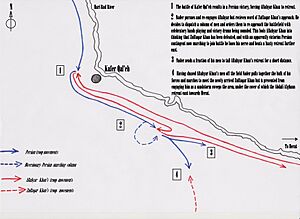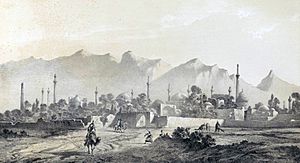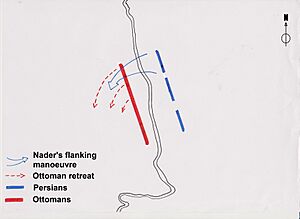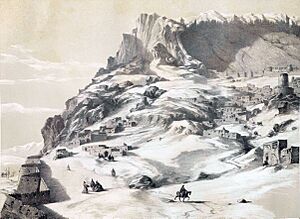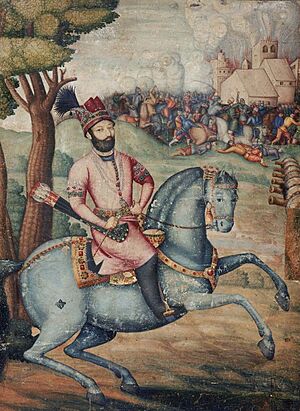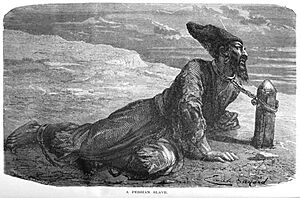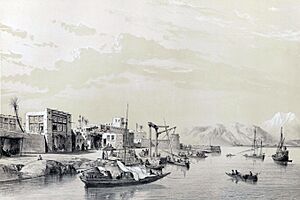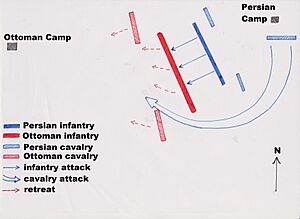Campaigns of Nader Shah facts for kids
Quick facts for kids Naderian Wars |
|||||||||
|---|---|---|---|---|---|---|---|---|---|
| Part of Ottoman–Persian Wars and Mughal–Persian Wars | |||||||||
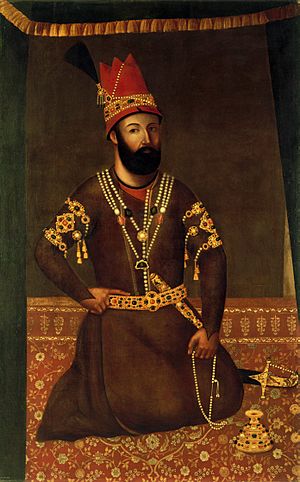 Portrait of Nader Shah |
|||||||||
|
|||||||||
| Belligerents | |||||||||
|
Empires of Persia:
|
Arab tribes Sadozai Sultanate of Herat Shaki Khanate Elisu Sultanate |
||||||||
| Commanders and leaders | |||||||||
Muzaffar Khan † |
|||||||||
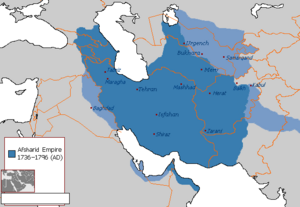
The Naderian Wars were a series of battles and campaigns led by the powerful Iranian leader Nader Shah in the early to mid-1700s. These wars helped Persia (Iran) become a strong empire again. They started after the Hotaki Afghans took over the Safavid dynasty in Iran.
After the Afghan invasion, Iran's capital, Isfahan, was captured. The country fell into chaos. A Safavid prince, Tahmasp II, asked Nader (who was a local leader in Khorasan) for help. Nader quickly became a brilliant military commander. He pushed back the Afghans and restored Tahmasp II to the throne.
Nader then fought to get back lands lost to the Ottomans and Russians. He won many battles, making Iran strong again. His success allowed him to take over the Safavid monarchy and start his own rule as Nader Shah, creating the Afsharid dynasty. He then conquered Afghanistan and invaded Mughal India, taking vast riches.
Later, Nader expanded Iran's power into Central Asia. However, his mental health worsened, and he became paranoid. His later campaigns were less successful, and he became very harsh. This led to many rebellions. Nader Shah was eventually assassinated by his own officers. His death caused a long period of civil war in Iran.
Contents
- Taking Back Khorasan
- Conquering Western Afghanistan
- Restoring the Safavid Empire
- Campaign in Western Iran
- Tahmasp's Failed Campaign
- Mesopotamian Campaign
- Afghan Uprising
- Conquering the Caucasus
- Conquering India
- Conquering Central Asia
- Conquering Daghestan
- Persian Gulf Invasion
- Second Ottoman War
- See also
Taking Back Khorasan
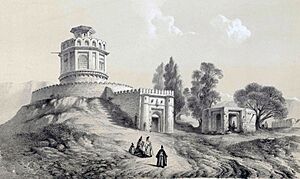
In the 1720s, the Afghan invasion caused many revolts in Iran. The Hotaki Afghan leader, Mahmud Hotaki, defeated the Persian army at the Battle of Gulnabad. He then captured Isfahan after a terrible siege.
A man named Malek Mahmoud Sistani made a deal with the Afghans. He would rule Khorasan as an independent kingdom, recognizing Mahmud as Shah. Sistani took control of most of Khorasan, including its capital, Mashhad. Meanwhile, Nader, with only 1,200 men, started raiding Sistani's lands. Nader quickly became the main challenge to Sistani's power.
Nader Joins Forces
After Isfahan fell, a Safavid prince, Tahmasp, claimed the throne. He was chased by Afghans and Ottomans. Tahmasp found a loyal but difficult leader named Fathali Khan of the Qajar clan.
They decided to start their fight in Khorasan to gather more troops. They met Nader, who joined them with his growing army. Nader had already fought and included many Kurds into his forces. Their combined army of 30,000 men began to besiege Mashhad. Sistani and his commander, Pir Mohammad, were trapped inside.
Tahmasp and Fathali Khan had a difficult relationship. Nader showed Tahmasp a secret letter from Fathali to Sistani. Nader advised Tahmasp not to harm Fathali, fearing the Qajar soldiers might leave. But Tahmasp had Fathali executed the next day.
Despite this, the Qajar soldiers stayed. The siege ended when Pir Mohammad betrayed Sistani, allowing Nader to enter the city. Sistani took refuge in the citadel and soon surrendered.
After the Siege
Malek Mahmoud Sistani was treated well at first. He was allowed to live as a wise man. However, he was executed the next year when Nader suspected him. The siege gave Tahmasp control of Khorasan's capital. It also made Nader the most powerful leader in the region. He continued to conquer other areas, making his army even stronger. This victory allowed the Safavid loyalists to plan their next move towards Herat.
Conquering Western Afghanistan
Nader Shah's conquest of Afghanistan involved many battles against the Abdali Afghans. Nader had just dealt with issues with his own monarch, Tahmasp II. He left Mashhad on May 4, 1729, making sure the Shah was with him for close watch.
This conflict was important because Nader's army improved its fighting skills. They learned to fight against fast light cavalry. This experience was very useful in later battles. The Abdali forces had 15,000 riders under Allahyar Khan, the governor of Herat. Another 12,000 men, led by Zulfaqar Khan, were also approaching.
Marching Towards Herat
The battle of Kafer Qal'eh was a win for Nader. He then chased Allahyar Khan. During the battle, Nader's scouts reported Zulfaqar Khan's approach. Nader used a clever trick. He sent a group of Iranian troops marching around Allahyar Khan's army, making loud sounds with drums and horns. This made Allahyar believe Zulfaqar Khan's men had already been defeated, so he quickly retreated.
As Allahyar fled towards Herat, Nader sent some of his army to follow. He kept most of his men to face Zulfaqar Khan. But a sandstorm hit the area, stopping the fighting. This allowed the Abdali forces to retreat to Herat safely.
The campaign had been a series of small fights and clever moves. Nader showed he was a quick-thinking commander. He outsmarted his enemies even in tough situations. However, the Abdalis were not destroyed. Nader followed them to Herat, where Allahyar and Zulfaqar's combined forces came out to fight him.
Capturing Herat
The final battle near Herat was similar to earlier fights. But this time, the Abdali charge was stopped by the Iranian infantry's musket fire. This broke the Afghan attack and forced them back behind the city walls. Herat was then heavily bombed by Iranian cannons. This convinced Allahyar Khan, the governor, to ask for peace. He agreed to recognize Iran's rule over Herat.
Nader's Smart Tactics
With Herat under Iranian control, the path to the heart of the Iranian empire was open. Liberating Isfahan now seemed possible. Nader had shown how effective his military system was. He had perfected how to defeat strong cavalry charges. His steady infantry, supported by cannons and cavalry on the sides, could break any mounted attack. This system would be tested in later, even bigger battles.
Restoring the Safavid Empire
The Safavid Empire was restored to power in Iran in late 1729. This happened after a series of battles between Nader, Tahmasp's chief commander, and Ashraf Hotaki. Even though Tahmasp was officially back on the throne, Nader held the real power. The Ghilzai Afghans were permanently driven out of Iran. In the years that followed, Nader brought them back into the Iranian empire.
Battle of Mihmandoost
Ashraf had put off fighting Tahmasp and Nader for too long. He heard about their campaign against the Abdali of Herat. Ashraf decided to march on Mashhad, hoping to capture it before Nader returned. But Nader was back in Mashhad well before Ashraf could invade.
Nader and Ashraf met near the village of Mihmandoost. Even though Nader's army was much smaller, they taught the Afghans a harsh lesson in modern warfare. Nader's well-trained army crushed Ashraf's forces, making him retreat.
Ambush at Khwar Pass
Ashraf retreated west and set up a clever ambush in the Khwar pass. He hoped to surprise the Iranians, who were celebrating their recent win. But Nader discovered the ambush. He surrounded and completely destroyed Ashraf's forces. The remaining Afghans fled towards Isfahan.
Battle of Murche-Khort
Ashraf asked the Ottoman Empire for urgent help. The Ottomans wanted Ashraf to stay in power rather than see a strong Iran rise again. So, they eagerly sent guns and artillerymen. At the battle of Murche-Khort, the Afghans were defeated again. Ashraf was forced to flee south.
Freeing Isfahan
Nader freed Isfahan. Soon after, Tahmasp II met him outside the city gates and thanked him. The Afghans had badly damaged the city, leaving little wealth. Tahmasp was very sad to see what had happened to the capital. The city had lost many people and much of its riches. The people took revenge on any Afghans they found hiding.
End of Afghan Rule
Nader left Isfahan for Shiraz, where Ashraf was trying to gather forces with local Arab tribes. There was no real hope for the Afghans to recover. Near Zarghan, the Iranian army fought and destroyed Ashraf's last army. Historical records differ on what exactly happened to Ashraf after this battle.
Campaign in Western Iran
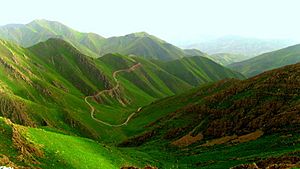
Nader's first campaign against the Ottomans was a great success. He proved to be a strong conqueror. However, Shah Tahmasp II decided to take command while Nader was away. Tahmasp's actions ruined Nader's gains. A furious Nader had to return and fix the situation. He forced Tahmasp to give up his throne to his infant son, Abbas III.
Ottoman Control
The Ottomans had moved into western Iran in the early 1720s. This happened when the Hotaki Afghans invaded the Safavid state. Mahmud Hotaki won a surprising victory near Gulnabad. This allowed him to march on Isfahan, which he captured after a six-month siege. The siege caused terrible suffering and loss of life. During this chaos, Russia and the Ottoman Empire took the chance to grab land. The Ottomans took western Iran and shared the Caucasus with the Russians.
Later, Ashraf became the new Afghan ruler. He marched west to stop the Ottomans and surprisingly defeated them. They made a deal: the Ottomans recognized Ashraf as Shah of Iran. In return, Ashraf accepted Ottoman rule in their new lands in the Caucasus and western Iran.
As Nader and Ashraf fought, the Ottomans supported Ashraf. They knew a strong Iran under Nader would be bad for their new territories. But Nader still completely defeated Ashraf's forces. He restored the Safavid state under Tahmasp II. Istanbul's fears came true: Nader would surely try to take back the lost lands. The Ottomans had been in western Iran for almost ten years. They would be a very tough challenge to remove.
Nader Marches on Nahavand
On March 9, 1730, the Iranian army left Shiraz. After celebrating the new year, Nader quickly marched west. He hoped to surprise the Ottomans. He reached the Ottoman-controlled town of Nahavand. Nader quickly drove the Turks towards Hamadan. There, the Ottomans regrouped in the Malayer valley, ready to fight. They hoped to stop the Iranian advance on Hamadan.
Battle of Malayer Valley
The Ottoman army Nader faced was different from his previous enemies. The Afghans and tribal groups mostly had excellent horsemen. They had almost no infantry or artillery.
Now, Nader faced an army similar to his own. The Turks lined up along a stream in the valley. Nader placed his men in three groups on the other side. As the armies got close, a general firing started. Smoke from muskets and cannons filled the air, hiding both armies. Under the smoke, Nader secretly strengthened his right side for a bold move.
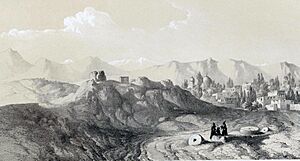
Nader ordered his right flank to charge across the stream. The Iranians appeared from the smoke, surprising the Ottomans. The Ottomans were confused by the sudden appearance of the enemy. Intense fighting followed for hours. The Ottomans tried to save their left side but failed. The Iranian attack cut deep into the Turkish left wing. When the chief Ottoman flag-bearer was killed, the army lost morale and fled. Iranian cavalry chased them, capturing many. It was a clear victory, opening the way to Hamadan for Nader's troops.
Nader Turns North
After freeing Hamadan and its 10,000 Iranian prisoners, Nader took Kermanshah. This freed large parts of western Iran from Ottoman rule. He left a fortified position and moved his army to Azerbaijan. He captured Tabriz on August 12, crushing an Ottoman army sent too late to help Tabriz. The Turkish prisoners were treated well. Nader freed many Ottoman leaders and sent them with messages of peace to Istanbul. In a quick campaign, Nader had brought back all the main provinces of Iran.
Tahmasp's Failed Campaign
Tahmasp's campaign was a failed attack into Ottoman-held Caucasus. It ended in a terrible defeat, losing all of Nader's gains from the previous year. Nader later fixed this military disaster. But it had a much bigger impact on the Safavid dynasty. Tahmasp II sealed his own fate by starting this ill-fated expedition. Nader had to cancel his planned invasion of Ottoman Caucasus. This was because the Abdali Afghans had rebelled and invaded Khorasan, besieging Mashhad. Nader gathered new recruits in northern Iran during the winter of 1731. He then went east to secure the empire's right side. Tahmasp II, who owed his throne to Nader, was convinced by his advisors to lead an army himself. Many historians believe Tahmasp was jealous of Nader's constant victories. Others think court members wanted their Shah to outshine Nader and reduce his power.
Campaign and Siege of Yerevan
At this time in Constantinople, a rebellion had brought Mahmud I to power. Sultan Mahmud I appointed a general to command in the east. This general would be Tahmasp's undoing. Tahmasp wanted to bring the Caucasus under Iranian control, like in his ancestors' time. He aimed to conquer Chokhur-e Sa'd, Georgia, and Daghestan from the Turks. An army of 18,000 men entered Chokhur-e Sa'd. Tahmasp won a victory over an Ottoman army near Yerevan.
Hakimoghlu Khan reacted quickly. He set out to break the siege of Yerevan. He realized Tahmasp had not protected his supply lines to the south. Hakimoghlu cut Tahmasp's connection to Tabriz. This forced Tahmasp to stop the siege and return to Tabriz. Tahmasp then heard that Ahmad Pasha was entering western Iran to take Kermanshah and Hamadan. Tahmasp was in a very bad situation. As the Iranian and Ottoman armies faced each other, they exchanged many letters. The Iranian army was mostly new recruits, as the experienced soldiers were with Nader in the east.
The battle started by accident when inexperienced Iranian infantry fired their muskets. The Iranian cavalry on the sides defeated their Ottoman counterparts. But the nervous infantry in the center fled easily when the Janissaries advanced. The Janissaries then helped their mounted comrades, routing the Iranian horsemen too. Tabriz also fell to Hakimoghlu Khan, and Ahmad Pasha captured Hamadan.
Tahmasp had to sign a treaty. He accepted Ottoman rule over the Caucasus. In return, he would get back Tabriz, Hamadan, and Kermanshah. This terrible foreign adventure resulted in one of the most humiliating treaties for his dynasty. But Tahmasp seemed not to care much. He soon returned to Isfahan to live a lavish life.
When Nader found out about the disaster in the west, he stopped his conquests in the east. He returned to Isfahan, furious at the Shah's poor leadership. Nader's impressive wins against the Ottomans the previous year were now meaningless. This gave Nader the power to force Tahmasp II to step down. Tahmasp's infant son, Abbas III, became Shah. This made Nader the supreme ruler, paving the way for him to completely overthrow the Safavid dynasty.
Mesopotamian Campaign

Because of Tahmasp II's mistakes in his invasion of the Ottoman Caucasus, all of Nader's earlier gains were lost. A humiliating treaty had been signed, giving the Caucasus to Istanbul. This gave Nader the power to force Tahmasp to step down. Nader then restarted the war against the Turks by invading Ottoman Iraq and Mesopotamia.
Attack on Kurdistan
Nader's choice to invade Ottoman-held Iraq seemed odd. All of Iran's western lands were back under Iranian control due to Tahmasp's treaty. But the Caucasus was still under Turkish control. Nader might have wanted to capture Baghdad to trade for the Caucasus. But Baghdad was a very important prize itself. So, it's unlikely he planned a simple trade. The Ottomans in the region were ready for the Iranians.
To surprise the enemy, Nader decided to march through the mountains. This was instead of directly attacking the fortified town of Zohab. The mountain path was difficult and snowy. Some soldiers died, but Nader got his 600 men into the valley behind the Ottoman defenses. He attacked in the middle of the night. The Zohab garrison was completely outsmarted. They woke up and fled in terror. Nader ordered a new fort built. He then moved south to join the main Iranian army, which had left Hamadan and was heading to Baghdad.
Crossing the Tigris
Nader left a small force of 7,000 to besiege Kirkuk. The main Iranian army marched on. They defeated an Ottoman army near Baghdad. Then, they surrounded Baghdad itself, preparing for a siege. This was after a tough campaign where Nader managed to cross the Tigris River. Ahmad Pasha defended the city stubbornly. He held out until a relief army of 80,000 men, led by Topal Pasha, arrived.
Battle of Samarra
Topal used a clever trick to draw Nader into a bad battle. Even though Topal lost a quarter of his own men, he crushed the Iranian army. Half of Nader's army was destroyed, and all his cannons were lost. This huge victory lifted the siege further south. Ahmad Pasha, hearing of Topal Osman's win, came out with his excited soldiers. They chased away the 12,000 Iranians who were blocking Baghdad.
Battle of Kirkuk
Nader made an amazing recovery from his huge losses. He rebuilt his army very quickly. He then invaded Ottoman Iraq again. After some small border fights, he sent Haji Beg Khan to lure out Topal Pasha, which he did successfully. The Ottoman advance guard was ambushed and overwhelmed. Nader then gathered his men and marched directly against the main Ottoman army nearby.
An intense musket fight happened along the entire line. Then, Nader ordered his infantry to draw their swords and charge the Ottomans. He supported them with a pincer movement by his cavalry reserves. This trapped Topal Osman's army in a circle of Iranian troops. The Turks crumbled. Not even the presence of the old, clever Topal Pasha could rally them. They fled, leaving all their cannons behind.
However, Nader could not continue his impressive conquest. A growing rebellion in southern Iran needed his immediate attention. So, Baghdad was saved from falling to the Iranians once again. This campaign did not decide the war's outcome. But it set the stage for Nader's Caucasus campaign in 1735. There, a crushing defeat of the Ottomans at Baghavard brought Istanbul to its knees.
Afghan Uprising
Zulfaqar Khan's Revolt
As the Iranian empire took back lost lands in the west, Hussein Sultan of Qandahar secretly encouraged the Abdalis of Herat to rebel. This happened while the main Iranian forces were fighting the Ottomans thousands of kilometers away. The governor of Herat, Allahyar Khan, who Nader had confirmed in his position after the 1729 war, remained loyal. But his chief officer, Zulfaqar Khan, was very much swayed by Qandahar's promises and support.
Siege of Mashhad
Allahyar Khan had to flee Herat and found safety with Nader's brother, Ibrahim Khan. The Abdalis soon invaded Khorasan itself. They marched on its capital, Mashhad, defeating Ibrahim Khan's Iranian forces. Ibrahim Khan's army had to retreat inside the city walls, which then came under siege. The Abdalis had little chance of taking the city. Their few cannons would not damage Mashhad's strong walls. However, these events worried Nader. He heard that his power base in Khorasan was in danger. On August 16, Nader left Tabriz and quickly marched his army 2,250 kilometers across Iran. He reached Mashhad to find the Abdalis in full retreat.
Siege of Herat
Hussein Hotaki became very worried about his position in Qandahar as Nader approached Herat. This made him start talks with Nader. He sent back some captured Safavid princesses. However, Hussein Sultan's support for Zulfaqar Khan did not stop. In fact, a Ghilzai force of thousands, led by Mohammad Seidal Khan, was sent from Qandahar to help Zulfaqar.
The Iranian army arrived in April 1731 in Noghreh, a few kilometers from Herat. They spread out to capture towers and strongholds around Herat. One night, Nader's small group of eight musketeers was trapped in a tower. Seidal Khan launched a surprise raid. Luckily for Nader, a unit of musketeers found the Afghan cavalry surrounding his tower and drove them away. Later, after crossing a bridge over Harrirud, the Iranians fought off a large Afghan counterattack. This forced the Afghans to retreat behind Herat's citadel walls. One night, Nader was resting in his tent. An Afghan cannon from the citadel fired a random shot. It landed right next to Nader's bed. His followers claimed he had divine protection.
The final battle happened outside the city. Zulfaqar Khan and Seidal Khan agreed to a joint attack against the Iranians. Nader sent a flanking force around the Afghans. He himself rode directly against their front with many cavalry. This attack destroyed the Afghans. Seidal Khan then left, which led to the remaining defenders of Herat asking for peace.
Allahyar Khan's Betrayal
Under the peace treaty, Allahyar Khan got his governorship of Herat back. Zulfaqar Khan was sent away to Farah. However, Nader did not occupy the citadel with his soldiers. This proved to be a big mistake. About 4,000 fighters came from Farah and restarted the rebellion. Allahyar Khan was pressured to join the revolt, even though he didn't want to. Allahyar Khan was also exiled.
The siege of the citadel started again. The Afghans sent peace messengers when they realized their difficult situation. The talks lasted a long time but finally ended. This allowed Zulfaqar Khan and his brother to escape to Qandahar. Herat was occupied but surprisingly not looted by Nader's troops. Ibrahim Khan managed to conquer Farah. This helped calm the region. Nader also moved many rebellious tribes and added many of their fighters to his own army.
Conquering the Caucasus
After Nader stopped the revolt in Afghanistan, he continued his invasion of the Ottoman Empire and the Caucasus. This ended in an Iranian victory. Nader was able to bring almost the entire Caucasus region back under Iranian control for the Safavid state.
Strategic Situation
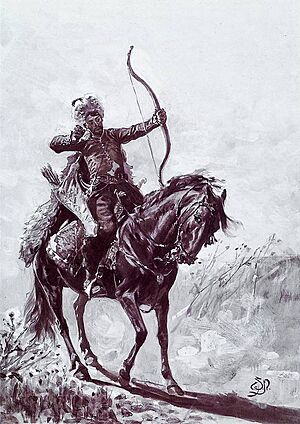
The Caucasus had been under Ottoman control since 1722, when the Safavid state collapsed. The first goal of Nader's campaign was to retake the Shirvan Khanate. Its capital, Shamakhi, fell in August 1734. This freed up Iranian forces to march west and besiege Ganja. Ganja's strong walls and 14,000 soldiers made it a tough defense. After Tahmasp Khan Jalayer defeated a combined Ottoman and Crimean Tatar force in the southeast Caucasus, Nader cut off their escape route further west. He dealt them another heavy blow, scattering them into the northern mountains.
The mountains in Avarestan to the north made chasing the defeated enemy very difficult, especially with winter coming. So, Nader chose to turn west and besiege Ganja. He faced a tough challenge trying to capture the surprisingly strong fortress. The Iranian artillery still lacked powerful siege guns. They mostly had field cannons, which were good in battles but couldn't do much damage to city walls.
Since their siege artillery wasn't strong enough, the Iranians sent sappers to dig tunnels under the citadel walls. But the Turks received timely information about this plan. As the Iranians and Ottomans dug underground, they met each other and fought hand-to-hand. The Iranians managed to set off six explosions, killing 700 Ottoman defenders. But they still failed to destroy the citadel walls. The Iranians also lost about 30 to 40 men.
Nader also blocked Yerevan and Tiflis. This forced a response from the Ottoman commander, Koprulu Pasha. Istanbul was not happy with the earlier peace talks by Ahmad Pasha, the governor of Ottoman Baghdad. So, they sent a huge army of 50,000 cavalry, 30,000 Janissaries, and 40 cannons. Koprulu Pasha was to command this army to defend Ottoman lands in the region.
Battle of Yeghevārd
Nader had besieged many key cities and forts in the area. He waited for Koprulu Pasha's main army. Nader's court historian, Mirza Mehdi Astarabadi, claimed this army had about 130,000 men. Nader gathered his advance guard of about 15,000 men and marched west to fight Koprulu Pasha's relief army. By the time the main Iranian army of 40,000 arrived, Nader had already defeated the Ottomans, despite the huge difference in numbers. This forced Istanbul to finally sign a peace treaty. It recognized Iranian control of the Caucasus and the border in Mesopotamia, which was already agreed upon in the Treaty of Zuhab.
The crushing defeat at Baghavard also convinced the 50,000 Crimean Tatars to retreat. They had been ordered by the Turkish Sultan to march south along the Black Sea coast to help Koprulu Pasha's forces.
Conquering India
Emperor Nader Shah, the Shah of Iran (1736–47) and founder of the Afsharid dynasty, invaded the Mughal Empire with a large army. He attacked Delhi in March 1739. His army easily defeated the Mughals at the battle of Karnal. He then captured the Mughal capital.
Nader Shah's victory against the weak Mughal Empire in the East meant he could turn back. He could restart the war against Iran's old enemy, the Ottoman Empire. He also planned more campaigns in the North Caucasus and Central Asia.
The Invasion
Nader Shah became the official Iranian monarch in 1736. He founded the Afsharid dynasty after his successful campaigns from 1730–35. In 1738, Nader Shah conquered Kandahar, the last stronghold of the Hotaki dynasty. He then began raiding across the Hindu Kush mountains into Northern India. At that time, India was ruled by the Mughal Empire.
The Mughal empire was weak from wars over who would rule after Aurangzeb died. Muslim nobles had gained independence. The Hindu Marathas had taken large parts of Central and Northern India. Its ruler, Muhammad Shah, could not stop the empire from falling apart. The government was corrupt and weak. But the country was very rich, and Delhi was still wealthy and important. Nader Shah, attracted by India's riches, wanted to plunder it like many invaders before him.
Nader had asked Muhammad Shah to close the Mughal borders around Kabul. This was to stop Afghan rebels he was fighting from hiding there. The Emperor agreed but did nothing. Nader used this as an excuse for war. With his Georgian ally Erekle II (Heraclius II), who led Georgian troops, the long march began. He defeated his Afghan enemies fleeing into the Hindu Kush. He also captured major cities like Ghazni (May 31), Kabul (June 19), and Peshawar (November 18). He then moved into the Punjab and captured Lahore. Nader reached the Indus before the end of the year. The Mughals gathered their army to fight him.
At the Battle of Karnal on February 13, 1739, Nader led his army to victory over the Mughals. Muhammad Shah surrendered, and they both entered Delhi together. The keys to Delhi were given to Nader. He entered the city on March 20, 1739. He took over Shah Jehan's imperial rooms in the Red Fort. Coins were made and prayers said in his name in the Jama Masjid and other Delhi mosques. The next day, the Shah held a grand meeting in the capital.
The Plunder
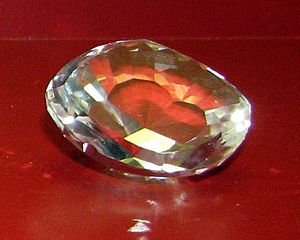
The city was looted for several days. A huge fine of 20 million rupees was demanded from the people of Delhi. Muhammad Shah gave Nader Shah the keys to the royal treasury. He also lost the Peacock Throne, which then became a symbol of Iranian power. Among many other amazing jewels, Nader also took the Koh-i-Noor and Darya-ye Noor diamonds. These are now part of the British and Iranian Crown Jewels. Iranian troops left Delhi in early May 1739.
Aftermath of the Invasion
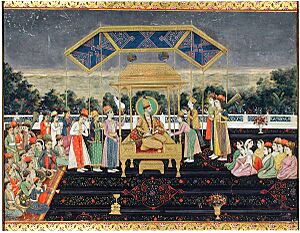
The wealth taken from Delhi was so great that Nader stopped taxation in Iran for three years after his return. Nader Shah's victory against the weakening Mughal Empire meant he could turn west. He could now face the Ottomans. The Ottoman Sultan Mahmud I started the Ottoman-Iranian War (1743–1746). Muhammad Shah worked closely with the Ottomans until his death in 1748.
Nader's Indian campaign showed the East India Company how weak the Mughal Empire was. It also showed them the chance to expand their own power.
Conquering Central Asia
In the mid-1700s, Nader Shah's Iranian empire began to conquer and take over the Khanates of Bukhara and Khiva. The first battles were fought in the late 1730s by Nader Shah's son, Reza Qoli Mirza. He won some important victories while Nader was invading India to the south. Reza Qoli's invasions of Khiva angered Ilbares Khan, the leader of Khiva. When Ilbares threatened to counterattack, Nader ordered his son to stop fighting. Nader later returned from Delhi and led a decisive campaign himself. After taking Khiva, he executed Ilbares. He replaced him with Abu ol-Fayz Khan, who Nader believed would accept his rule more easily. This conflict resulted in a huge Iranian victory against the Central Asian khanates. With his earlier conquests in northern India, Nader's empire in the east became larger than any other Iranian empire before it, even the ancient Sassanians and Achaemenids.
Conquering Daghestan
The conflict between the Iranian Empire and the Dagestan people was fought on and off. It started in the mid-1730s during Nader's first campaign in the Caucasus. It continued until the very last years of his rule and his assassination in 1747. The very difficult mountains of the northern Caucasus made it extremely hard to control the Dagestan people. Despite this, Nader Shah captured many strongholds and forts from them. He pushed them almost to defeat. However, the Dagestan people held on in the northernmost parts of Daghestan. They continued to resist Iranian rule. The conflict lasted many years. Only a few years saw intense fighting, usually when Nader himself was present. Otherwise, it was mostly small fights and raids. Most Iranian casualties were due to extreme weather and disease. This, combined with the Dagestan people's strong will to fight back and retreat to their distant strongholds when threatened, made the war a difficult situation for Nader's forces. In the end, the Dagestan people, who had held out in the northern forts, marched south when they heard of Nader's assassination. They took back most of their lost lands as the Iranian empire fell apart.
Persian Gulf Invasion
The Afsharid Conquest of the Persian Gulf was an effort by Nader Shah's Iranian Empire. He wanted Iran to be the main power in the Persian Gulf and nearby areas. The many campaigns at first were very successful. They achieved many goals. However, a rebellion by Nader's appointed Admiral, Mohammad Taqi Khan, caused problems. It affected the many small states around the Persian Gulf that Iran had taken control of. Even after Mohammad Taqi Khan was defeated and captured, the Iranian empire faced a difficult time. There was constant fighting and civil war because of Nader's increasingly harsh rule. This led to the empire collapsing right after his assassination. As a result, many of the conquests in the region were lost.
Second Ottoman War
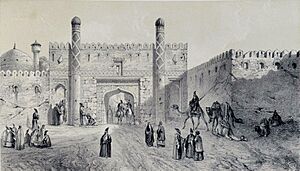
Nader tried to confirm the Treaty of Constantinople (1736). He demanded that the Ja'fari, a small Shi'ite group, be accepted as a fifth legal sect of Islam.
In 1743, Nader Shah declared war on the Ottoman Empire. He demanded that Baghdad surrender. The Iranians had captured Baghdad in 1623 and Mosul in 1624. But the Ottomans had taken back Mosul in 1625 and Baghdad in 1638. The Treaty of Zuhab in 1639 between the Ottoman Empire and the Safavid Empire brought peace for 85 years. After the Safavid dynasty fell, Russia and the Ottoman Empire agreed to divide northwest Iran and the Caspian region. But when Nader Shah rose to power, the Russians and Turks left the area. Nader Shah fought the Ottomans from 1730 to 1736, but it ended in a tie. Nader Shah then turned east and invaded the Mughal Empire in India. He did this to get money for his wars against the Ottomans.
The War
Nader Shah dreamed of an empire stretching from the Indus River to the Bosphorus Strait. So, he raised an army of 200,000 soldiers. Most of these were rebellious Central Asian tribesmen. He planned to march towards Constantinople. But he learned that Ottoman religious leaders were preparing for a holy war against Iran. So, he turned east. He captured Kirkuk, Arbil, and besieged Mosul on September 14, 1743. The siege lasted 40 days. The Pasha of Mosul, Hajji Hossein Al Jalili, successfully defended Mosul. Nader Shah was forced to retreat. The attack stopped because of revolts in Iran (1743–44) over high taxes. Fighting also spread into Georgia. There, Prince Givi Amilakhvari used an Ottoman force. He tried to weaken Iranian influence and remove Nader's Georgian allies, Princes Teimuraz and Erekle.
In early 1744, Nader Shah restarted his attack. He besieged Kars. But he returned to Daghestan to stop a revolt. He came back later and defeated an Ottoman army at the battle of Kars in August 1745. The war fell apart. Nader Shah became mentally unstable. He started punishing his own people, which led to a revolt from early 1745 to June 1746. In 1746, peace was made. The borders stayed the same, and Baghdad remained in Ottoman hands. Nader Shah dropped his demand for Ja'fari recognition. The Ottoman government was pleased and sent an ambassador. But before he could arrive, Nader Shah was assassinated by his own officers.
See also
- Military of the Afsharid dynasty of Iran
- Safavid Empire
- Afsharid Empire
- Ottoman Empire
- Russian Empire
- Mughal Empire
- Treaty of Ganja
- Treaty of Constantinople


